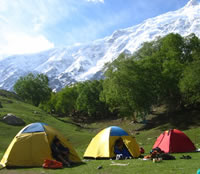The first thing new campers have to figure out when they reach their destination is how to turn a given spot in the woods into a livable space. Learning how to find and set up a campsite is essential to having a fun and comfortable outdoor experience. Finding the right spot will serve to protect your party from the elements and make your stay more amenable. For a basic guide on finding a campsite that will do both, read on.
Finding a Spot
 When it comes down to basic preferences, there are pretty much two types of campers. The first prefers a pre-made campground, complete with bathrooms, barbecue pits, and trash cans within short distance. These spots are usually cleared of rocks and other debris that can make sleeping uncomfortable. The drawback, however, is that you’ll likely have to share the area with other camping parties. The second type is a little more adventurous. They prefer to hike until they find a spot that naturally caters to camping. It is typically flat, relatively debris free, and has enough room for tents, cooking areas, and places in which to relieve themselves nearby. Though a little more difficult to find, the obvious advantage is that the area you claim will be your party’s alone for the length of the stay.
When it comes down to basic preferences, there are pretty much two types of campers. The first prefers a pre-made campground, complete with bathrooms, barbecue pits, and trash cans within short distance. These spots are usually cleared of rocks and other debris that can make sleeping uncomfortable. The drawback, however, is that you’ll likely have to share the area with other camping parties. The second type is a little more adventurous. They prefer to hike until they find a spot that naturally caters to camping. It is typically flat, relatively debris free, and has enough room for tents, cooking areas, and places in which to relieve themselves nearby. Though a little more difficult to find, the obvious advantage is that the area you claim will be your party’s alone for the length of the stay.
Making the Site “Campable”
Regardless of whether you decide on a designated campground or natural clearing, there are a few things you should take note of before you begin to unpack your gear. First, the area should be checked for debris. Though campgrounds are relatively clear to begin with, things have a way of accumulating in clearings of any type. Pay special attention to the general spot where you want to place your tent, making sure every rock and anthill is surveyed so you know which specific areas to avoid. If you’re anywhere near a river or creek, consider moving the entire potential campsite to higher ground, as flash flooding or even slight rises in water level can wash out the campsite in a hurry. Likewise, camping at the base of a hill has the potential to induce an uncomfortably wet, muddy camping experience.
Setting Up Camp
So, by now you’ve found the perfect spot for your tent and living space, and it’s finally time to set up the campsite itself. Start by laying down some tarp under where the tent will go, as it will serve as a buffer between you and the cold, sometimes wet ground. Then, set up the tent, and get your things (except food, of course) inside it. For the kitchen area, find the nearest picnic table if you’re at a campground. If you’re not, then bring a small folding table or some other flat surface that you can prepare and serve food on. Leave all your food there, as it will keep any nosy critters away from where you sleep at night. Those at a campground are set after this step. Those who found their own spot, however, should set up a designated trash area complete with bags, use rocks and a shovel to create a small fire pit (if allowed in that area), and potentially dig a shallow, compact latrine a good distance away from the campsite.
By getting all of the work that goes into locating and setting up a campsite out of the way early, you can maximize the time for fun during the trip. So, while otherwise you might be busy gathering trash or clearing pebbles from under the tent, you can instead be sitting around the fire, fishing, or hiking with your friends and family.


Thanks for the tips on finding a good campground. Like you said, the spot is vital to having fun and enjoying your stay outdoors. I don’t mind camping, but it has to be on smooth ground, with some hefty padding, preferably.
Your article makes no mention of Leave No Trace when setting up a campsite, for example, camping on durable surfaces like dirt, rock, sand, or grass but not on woody plants or moss or ferns. In addition, your article provides a perfect opportunity to discuss disposing of human waste, cat hole digging or using a WAG bag. A responsible camper minimizes it’s foot print on the environment he/she is enjoying to save it for others and the next generation.
Also checking the forecast so we can choose which would be the best spot to be out campground. It’s better to prepare for the unexpected, right?